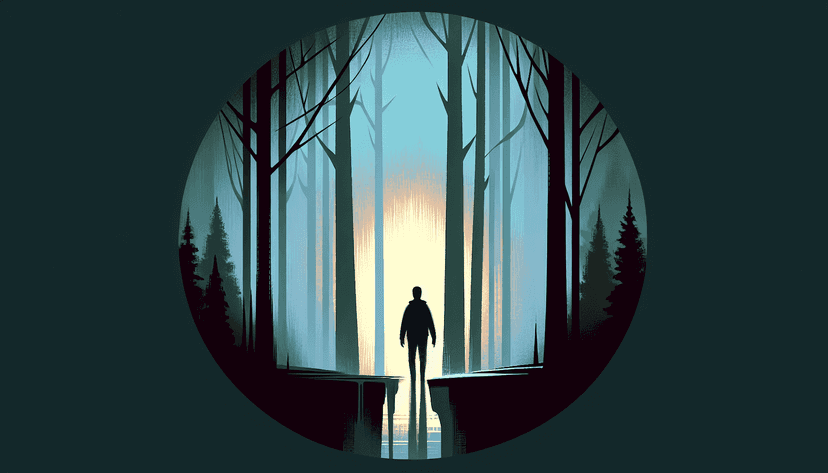Table of Contents
Building suspense in writing can feel like a high-stakes game of tug-of-war. Readers crave excitement, yet keeping them on the edge of their seats isn’t an easy task. You might be wondering how to weave tension into your storytelling without losing your audience along the way.
But don’t worry! If you stick with me, I promise to share some valuable techniques that will help you master the art of suspense. By the end, you’ll have a toolkit for creating gripping narratives that keep readers guessing and glued to every page.
We’ll explore strategies like controlling information, using foreshadowing, and adjusting pacing to crank up the tension throughout your story. Get ready to dive into the thrilling world of suspenseful writing!
Key Takeaways
Stefan’s Audio Takeaway
- Control information by revealing just enough to hook readers while keeping the bigger picture hidden.
- Use foreshadowing to drop subtle hints that build anticipation without giving away key details.
- Create an engaging atmosphere with vivid settings that enhance tension and evoke emotions.
- Adjust pacing with short sentences for excitement and longer, descriptive ones for slow moments.
- Add obstacles and complications to keep characters challenged and raise reader uncertainty.
- Develop characters fully so readers feel invested in their struggles and decisions.
- Introduce time limits to create urgency and heighten suspense.
- Incorporate plot twists that redefine the story and keep readers on their toes.
- Choose narrative techniques that enhance suspense, like unreliable narrators and cliffhangers.
- Maintain suspense consistently throughout the story by revisiting conflicts and building tension gradually.

1. Master the Control of Information to Build Suspense
Building suspense is all about what you choose to reveal and when you choose to reveal it. You want to give just enough information to hook your readers but keep them in the dark about the bigger picture. Think of it like a magician’s trick; show them the shiny object but don’t let them see how it’s done. For example, if your main character is uncovering a conspiracy, drop hints without revealing the whole story upfront. This method can keep readers turning pages, eager to piece together the puzzle.
Another effective technique is to start with a gripping situation that raises questions right away. For instance, beginning with a scene of a character in peril can create an immediate sense of urgency. This forces readers to ask, “What happened?” and “How will they get out of this?” The goal is to keep them guessing, and you can do this by strategically withholding critical information.
2. Use Foreshadowing and Hints to Keep Readers Guessing
Foreshadowing is a powerful tool that allows you to drop subtle hints throughout your story. These hints can create anticipation and prepare readers for future events without giving too much away. For instance, if a character is going to face a big betrayal, sprinkling in small, seemingly inconsequential moments can enhance the payoff. Readers love the reward of going back and discovering those clues.
Think about introducing an enigmatic character whose true motives remain unclear. When readers encounter them, they may sense that this character is somehow linked to future conflicts. You can keep the tension alive by leaving breadcrumbs that lead back to this character later in the story. Just remember to balance your hints carefully; too few can leave readers confused, while too many can spoil the surprise.
3. Create an Engaging Setting and Mood for Tension
The setting of your story can greatly influence the mood and sense of tension. A well-crafted environment can elevate suspense simply by being atmospheric. Imagine setting your scene in a dimly lit, abandoned house on a stormy night. The howling wind and creaking floorboards can heighten feelings of unease, compelling readers to feel the tension as they turn each page.
To enhance this further, use vivid descriptions that engage the senses. Describe not just what characters see, but what they hear, smell, and feel. This helps readers immerse themselves in the atmosphere. For example, a character might smell damp earth after a rainstorm or feel the chill of the air as they nervously await an unknown visitor. These elements help cultivate an emotional response that keeps readers on the edge of their seats.

4. Adjust Pacing and Sentence Structure to Heighten Suspense
Pacing is crucial in building suspense. It dictates how quickly or slowly a story unfolds.
Start with shorter sentences during high-stakes moments to create a frantic pace that mirrors the character’s emotions.
For example, instead of saying, “He walked cautiously through the door,” try something like, “He stepped in. Silence. Where was everyone?”
This shift not only accelerates the reader’s heart rate but also keeps them engaged.
Conversely, when you want to slow the pace, use longer, more descriptive sentences that allow readers to savor the moment. Balance is key.
Also, manipulating chapter lengths can maintain suspense. Short chapters can create anxiety, as each section offers a new cliffhanger. Consider how a sudden mid-chapter break can amplify tension.
5. Introduce Obstacles and Complications in the Plot
Obstacles are the bread and butter of tension. They keep characters from achieving their goals, which adds suspense.
Think of a character on a quest—just when they think they’ve found the solution, an unexpected twist occurs, like a lockdown in the city due to a natural disaster.
This not only complicates their plans but also creates uncertainty for the reader. Will they achieve their goal? What else will they have to overcome?
For instance, if your protagonist discovers a secret about their best friend, don’t let it come easy. Introduce a third character who complicates matters, leading to intense conflict.
By layering obstacles, you build tension and keep readers guessing.
6. Develop Characters to Increase Emotional Stakes
Readers genuinely connect with well-developed characters. When characters have depth and backstories, their actions carry more weight.
For example, if a character risks everything to save a loved one, readers feel that tension alongside them. This creates empathy.
Consider adding flaws to your characters, as these imperfections can lead to poor choices that escalate the suspense. A reckless decision might put the character in danger, increasing reader investment.
Take time to reveal character motivations. Understanding why a character acts as they do heightens emotional responses. Perhaps a character’s hasty decisions stem from past trauma, making their struggle relatable.
Doing this makes readers feel the stakes are personal and, in turn, builds suspense.
7. Add Time Limits and Deadlines for Urgency
Time constraints create a ticking clock that ratchets up the suspense. When characters are racing against a deadline, readers feel the adrenaline.
For example, if a character must solve a mystery within 24 hours, readers are more likely to turn pages quickly. The fear of failure looms large.
You could also introduce countdown elements where the character’s fate hangs in the balance. Think bomb scenarios or time-sensitive deliveries that add pressure.
Be sure to show how time affects your characters. Are they panicking? Are they trying to keep cool? This adds to the urgency and keeps readers engaged.
Essentially, a time limit can turn a mundane scenario into a nail-biting event, leaving readers on the edge of their seats.
8. Incorporate Plot Twists and Unexpected Turns
Nothing raises suspense like a good plot twist. It invigorates the narrative and forces readers to rethink everything they’ve read.
To implement this, consider planting seeds of doubt. Maybe a character you’ve portrayed as trustworthy secretly has ulterior motives.
This not only keeps readers intrigued but also hooks them into the story. They’ll want to see how the plot unfolds.
Don’t shy away from shocking twists but be careful not to force them. The best twists often make perfect sense in hindsight.
By weaving plot twists seamlessly into the storyline, you’ll maintain suspense and keep readers engaged until the very last page.
9. Choose the Right Point of View and Narrative Techniques
The point of view can drastically affect how suspense is delivered. First-person narration creates intimacy, allowing readers to feel a character’s anxiety directly.
On the other hand, third-person limited can provide insight into multiple characters, building suspense through contrasting perspectives. For instance, showing what different characters are up to can create tension as readers start to piece together the bigger picture.
Experimenting with unreliable narrators can also be effective. This technique keeps readers guessing who to trust and adds layers of complexity.
Finally, using cliffhangers at the end of chapters can be a powerful technique. Leaving readers hanging with burning questions compels them to read on.
10. Maintain Suspense Throughout the Entire Story
Sustaining suspense is an art. It starts early and should be woven into every chapter.
To maintain suspense, periodically revisit threats and conflicts introduced earlier, allowing them to evolve.
Create a rhythm of tension and release, pacing the buildup to keep readers engaged. This helps maintain interest throughout.
Don’t shy away from emotional stakes or high-tension moments. The goal is to keep readers invested in the outcome while exploring character dynamics.
Consistent tension throughout the narrative ensures your readers are on the edge of their seats until the very end.
Conclusion
Building suspense in storytelling requires a delicate balance of techniques. By effectively controlling information, implementing clever foreshadowing, engaging settings, and character depth, authors can craft gripping narratives.
Remember to manipulate pacing and introduce obstacles wisely while utilizing time limits to escalate tension.
And, of course, don’t forget the power of plot twists to keep readers guessing.
These strategies will help you create a captivating reading experience, drawing your audience in until the very last page.
By employing these techniques, your journey into storytelling will surely take on a more thrilling tone, while engaging your readers in a real and impactful way.
For more strategies on effective storytelling and narrative techniques, check out how to get a book published without an agent or explore horror story plot ideas.
FAQs
To build suspense, master the control of information by strategically revealing details, using foreshadowing, and creating tension-filled settings. The right pacing and character development also enhance suspense by keeping readers engaged and on edge.
Foreshadowing sets the groundwork for future events, keeping readers guessing about potential outcomes. By providing subtle hints and clues, you can maintain an air of mystery which sustains suspense throughout your narrative.
Introducing obstacles complicates the plot, heightening tension and making it harder for characters to achieve their goals. This increased challenge engages readers, amplifying emotional investment and anticipation as they wonder how characters will overcome these hurdles.
Choose a compelling point of view and employ narrative techniques like cliffhangers, tight pacing, and strategic chapter breaks. These methods keep readers engaged and anxious to discover what happens next, sustaining suspense throughout the story.



